Hannibal
New member
I have to admit this is one very interesting, and amusing thread.
Stay tuned and watch the sparks fly
Follow along with the video below to see how to install our site as a web app on your home screen.
Note: This feature may not be available in some browsers.
I have to admit this is one very interesting, and amusing thread.
What do you look for in an area that you may set up on and look for bear? Marshy wet conditions are where I find sign. What food sources do you look for? Spring flowers(being serious some are sweet)?
Ridgerunner Outfitters of Kamiah,( pronounced Kam ee eye) Idaho offers such a service in unit 10. Check out Kiwi's Econo Hunt thread in this forumIs there such a thing as outfitters providing a bait site only?
I really want to spot and stalk but a bait site would make me feel like I took out an insurance policy for the hunt. Sports and stalk for the first 6 or 7 days then if need be sit a bait for 3 or 4 days to fill a tag.
Need an Air BnB service for bait site. Haha
What do you look for in an area that you may set up on and look for bear? Marshy wet conditions are where I find sign. What food sources do you look for? Spring flowers(being serious some are sweet)?
Nice bear, El Unit. What's he got in his mouth there? Looks like a tea berry leaf. (?)
That or kinnikinnick leaf.
I agonized over and threatened to write this thread for quite some time due to the misinformation and lack of information regarding this subject in the bear hunting forum. Since the Idaho spring bear season opens in about 8 weeks I thought it would be a 'somewhat appropriate time' to provide advice to help less experienced spring bear hunters succeed in their quest to bag a black bear. Most of the information in this thread is a collection of posts I've contributed to other threads in the bear hunting forum of this website since becoming a member.This thread is about spring, not fall bear hunting. Each season in my opinion requires somewhat different tactics. Black bear pelts and claws are not in their prime condition in the fall. That's why I don't hunt them in the fall and you sure as hell shouldn't be hunting then also. I killed my first spring black bear years ago after reading a magazine article about spring bear hunting in north central Idaho. Since then I've harvested and observed many black bears in north central and other areas of the state of Idaho as well. With that said let's begin. 1) Hunt in areas that have high harvest numbers. You'll increase the odds for success if you hunt only in areas which support a large number of bears. If that means traveling a greater distance to reach better bear habitat then drive the extra miles. Why waste your time and efforts in a less productive area? 2) Timing is very important. After bears emerge from hibernation they're almost always found at lower elevations and in ' higher concentrations' than at other times in the year. In the fall black bears tend to be more dispersed and more difficult to locate. Focus your hunting efforts in the early to mid spring season for increased sighting opportunities. 3) Black bears may be nocturnal, diurnal or both. I've had many black bear sightings over many years and I have rarely seen bears during morning or early afternoon hours. The best time for spotting spring black bears is roughly between 4:00 p.m. and sunset. Don't waste your time hunting them earlier in the day. 4) Black bears may have a home range of 10 to 60 square miles or more. According to an Idaho study, male bears in Idaho have an average home range of 8 1/2 square miles. Do you honestly believe you'll succeed in attracting them to your bait, mouth or electronic calls? Yes it does happen, but don't bet your 2017 bear tag on it. Since they're not likely to come to you, you'll have to go to them. Search areas near streams, creeks, beaver ponds, marshes and swamps. These are natural corridors and provide food sources for bears in the spring. When you locate scat, tracks or other sign you can be certain that particular location is being frequented by bears on a regular and often, almost daily basis. There you have it condensed, concise and accurate information, everything you need to become a successful Idaho spring bear hunter.
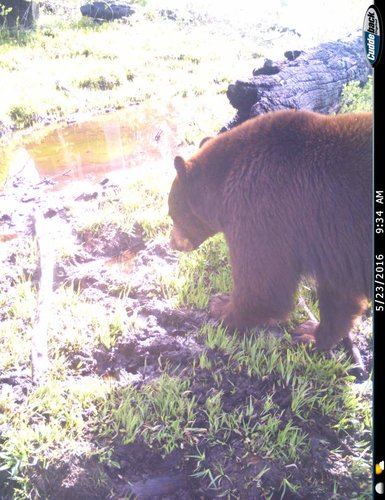
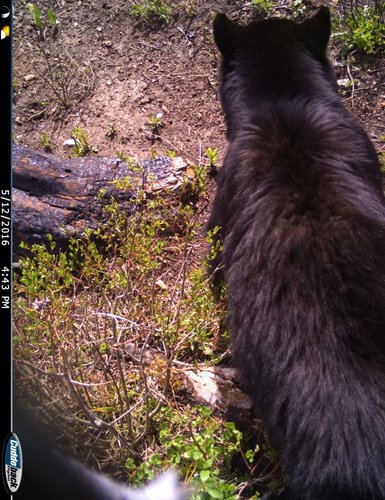
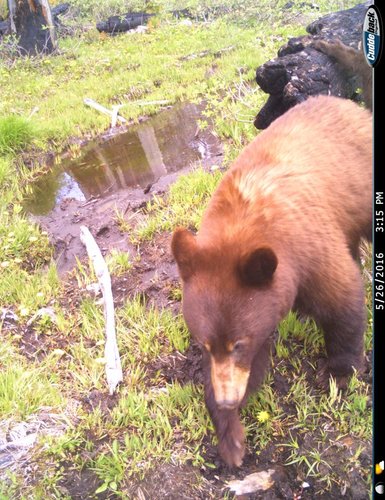
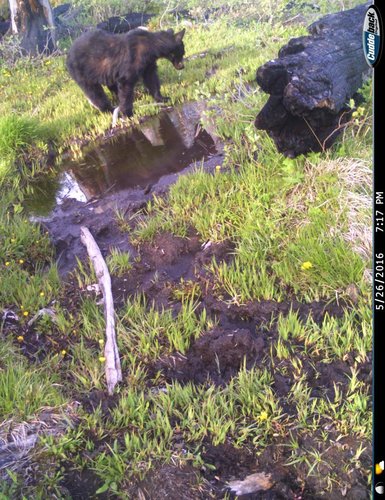
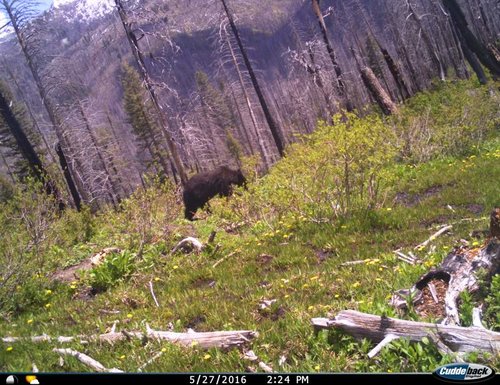
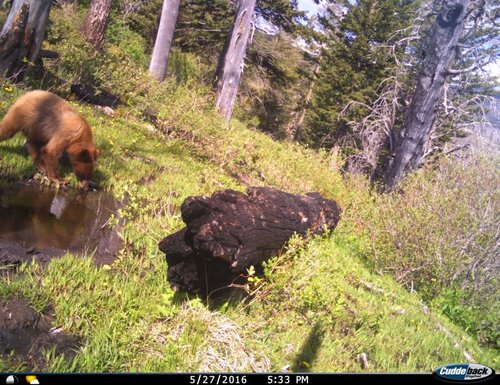
Is this a joke? I have been on over 40 successful black bear hunts in NE WA and ID and half the stuff you wrote here is about a false as it gets! Please enlighten us on why in the " hell we shouldn't be hunting black bears in the fall" First off a fall bear has far better meat than a spring bear after it has spent all summer gorging on berries a bear shot in the fall is up to 40% heavier than in spring. I can remember 2 bears of all the falls we have shot with bad hides the rest have had spectacular hides. I can tell you with spring you can get a phenomenal hide or rubbed hide and half of the springs we have shot have rubbed! and the remark about claws doesn't even dignify a response. Your logic with bears and "home range" and bait is laughable! have you ever baited? obviously not. In the fall we have taken 70% of our bears first thing in the morning. Bears move into places to feed at night and usually wont travel far at night (due to very bad eye sight) at a good food source. This is also the coolest part of the day and if you are in position at light bears will be still out and about as its still cool and feeding and as the sun creeps on to them they move into cover, also with this logic if there are bears near your vantage and you don't see them right away wait till the sun begins to hit the hillside you may see a bear making his way to cover for the day. In the fall as its generally hot in most of the west, bears are in no hurry to be getting out and generally wont move out of cover till it begins to shade.. this also applies in the spring if it starts getting hot in May and June..they have winter hides and black and brown hides in the sun heats up and bears move to shade. The comment about fall bears being "more dispersed" is very inaccurate! Fall is about as good as it gets for find "A" hillside with anywhere from 1-7 bears on it! Fall is all about food and the food source which is berries,apples and pears from July to mid September.... berries need sun and that generally means west and south facing slopes. Unlike spring there is tons feed, fall there is very minimal and berries and fruit trees are the last of high quality forage going into October you find the feed in the fall you will find the bears and usually several.Bears will congregate on good hillsides with berries and makes bear hunting pretty easy once you find these spots. Spring bears wake and usually start with eating skunk cabbage and move on to grasses... this stuff is growing virtually everywhere come May and beyond with bears gorging on it with no rhyme or reason. You could spot a bear in any opening in the spring with grasses which means bears can be spread out everywhere all the way to the snow line and once the snow is gone the bears can be very low to the very top.
Thank you for your response. Before I respond please read the title of my thread "Idaho SPRING Black Bear Hunting for Dummies" and consider its' relevancy to your comments such as " berries and fruit trees", " apples and pears from July to September" and " good hillsides with berries". Now relax and focus. With that said, let's get started. 1) Some people prefer geologic cuisine such as limestone, others granite. Please read my recommendations on butchering, preparation and cooking. Enjoy. 2) Congratulations on your successful NE (Nebraska) black bear hunts. Does Nebraska offer nonresident otc tags? Try not to strain the limits of your credibility. 3) Please refer to the following authoritative sources for information on black bear home ranges: Idaho State University, Montana State University and Western Wildlife Outreach. If you wish to contest their expertise of the subject matter please submit the results of scientific studies you've conducted for the benefit of forum member evaluation. 4) All black bears rub, especially male bears. Evidence of rubbing is present by late May or June. However, rubbed pelts may be an indication of the animal's health as well, a subject I'll address in an addition to this thread. Please visit your local taxidermist or zoo for details. 5) Nocturnal, diurnal or both I have rare seen spring bears during morning or early afternoon hours. Bear activity may be dependent on human activity, time of year, food supply etc.. The best time for sighting spring bears from my experience is from about 4:00 p.m. to sunset. 6) Alternative methods of spring bear hunting and your recommendations are subjects which you may wish to address in a thread for evaluation by members of this forum. 7) Though research suggests bears may not be strictly territorial, your observations of 7 bears on "'A' hillside" stretch the limits of your credibility. Incoherent ramblings about berries, apples, pears and fruit are more appropriate for the produce section of Albertson's supermarket than this thread and clearly suggest an inability to focus on the subject of spring black bear hunting. Comments regarding lack of disparity in claw condition and uncommon occurrence of rubbed pelts indicate serious inexperience. As for the authoritative sources cited, if you wish to contest their studies and expertise of the American black bear, I suggest you submit a photo of your latest roadkill which you feel supports your position. Thank you
Congratulations on your successful NE (Nebraska) black bear hunts. Does Nebraska offer nonresident otc tags? Try not to strain the limits of your credibility.
reading this crap you have posted is like reading someone who has hunted bears a handful of times...its laughable. And NE WA stands for North East Washington and N ID stands for North Idaho.
As a long time Idaho big game hunter I have watched the license fees sky rocket over the years for residents and nonresidents.